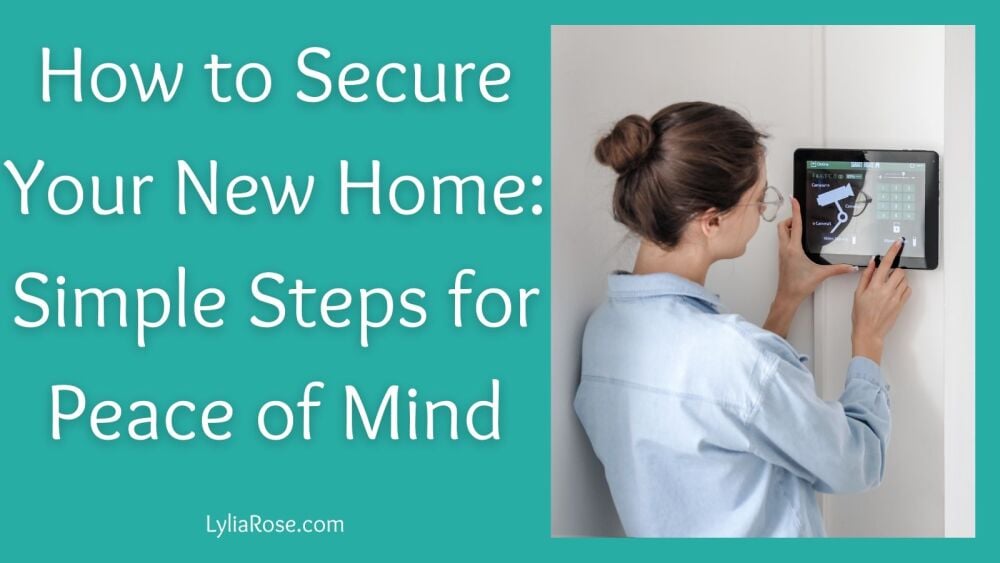How to Secure Your New Home
Posted on
Moving into a new home is exciting. Fresh beginnings, new memories, a space that’s finally yours. But before you get too cosy arranging the sofa or hanging that first picture, take a moment to think about security.
Because even if your new place feels safe, you can’t really know who still has a key, how strong those old locks are, or whether your windows are as secure as they look.
This isn’t about paranoia. It’s about peace of mind. A few smart steps now can save you stress later — and might even lower your home insurance.

Set Up a Security System
Let’s start with the big one: a home security system.
You don’t need a huge budget these days. There are loads of affordable DIY systems that send alerts straight to your phone, or you can go for professional monitoring if you prefer.
If you’re not sure where to start, look for something that covers the basics — a camera, alarm, and motion detection. A visible home security camera alone can make a huge difference. Burglars often skip homes that look protected.
And if you want that extra peace of mind, pick a system that connects to your smartphone so you can check in anytime, wherever you are.
Secure Your Doors
Your front door is your first line of defence. It’s amazing how many break-ins happen simply because a door wasn’t locked properly or the frame was weak. So always make sure you secure the doors as a priority.
Check your door frame feels sturdy and your hinges are secure on the inside, not exposed. If you’ve moved into a previously owned property, change the locks straight away — you never know who might still have a copy.
If your door has a letterbox, fit a guard to stop anyone reaching through. And consider a video doorbell or door chain for a simple but powerful upgrade.
Install a Deadbolt or Smart Lock
Deadbolts make a huge difference. A simple latch can be forced open, but a good deadbolt resists that. Choose a Grade 1 or Grade 2 model if you can, and pair it with a reinforced strike plate for maximum strength.
Smart locks are another great option. They let you lock and unlock doors from your phone, check who’s coming and going, and even set temporary codes for guests.
An added bonus? Insurers love these upgrades. Some will lower your home insurance premiums if you’ve got certified security in place.
Lock and Reinforce Your Windows
Windows are a common weak spot, especially on the ground floor.
Swap flimsy factory latches for key-operated locks or smart sensors that alert you if a window’s opened unexpectedly. Security film is another clever addition — it’s invisible but helps stop glass shattering easily.
For natural deterrents, plant thorny bushes beneath windows. Keep them trimmed so they don’t become hiding spots, but they’ll make any intruder think twice before climbing through.
Light Up Your Garden and Driveway
Criminals prefer darkness. You can make your home far less appealing with a bit of well-placed lighting.
Motion-activated lights at entrances, garages and along the driveway are brilliant — they save energy and startle anyone lurking about.
If you prefer something softer, solar lights along the paths and fences look good and keep your outdoor areas bright enough to spot movement.
The aim is to remove dark corners where someone could approach unnoticed.
Don’t Forget the Garage
Garages are often overlooked, yet they’re full of valuables — bikes, tools, garden equipment — and sometimes even an unlocked route into the house.
Keep both interior and exterior doors locked. If you have an electric opener, disconnect it when you’re away for long periods.
You can also fit a smart garage system so you’ll get an alert if you’ve left it open. And it’s worth checking if your home insurance covers the contents. Some policies don’t include outbuildings unless you add them.
Review Your Home Security Regularly
Security isn’t a one-off job you tick off a list. It’s something to review every few months.
Walk around your property at night. Are there dark areas near the doors or garden shed? Could someone get close without being seen?
A quick look like that can reveal small weaknesses you can fix easily — sometimes just adjusting a light or tightening a latch makes all the difference.
You could even book a security audit if you want an expert opinion. They’ll spot details most of us overlook.
Make It Look Like Someone’s Home
Burglars usually go for houses that look empty. Simple tricks can make yours look lived-in even when you’re not there.
Use timers for lamps so lights switch on in the evenings. Leave a radio on low when you pop out. Ask a neighbour to move your bins or pick up post when you’re away.
If you want a more modern touch, smart plugs and lighting systems let you control everything remotely from your phone.
Protect Your Peace of Mind
Ultimately, securing your new home isn’t just about locks, alarms and cameras. It’s about creating a place where you feel truly at ease.
Start small. A solid lock here, a camera there, a light or two outside. You don’t have to do it all at once — just keep improving bit by bit.
Because the goal isn’t to build a fortress. It’s to make your home somewhere you can relax, knowing you’ve done what you can to keep it safe.
Quick Recap: How to Secure Your New Home
To secure your new home, start with strong locks on doors and windows, add outdoor lighting, and install a reliable alarm or smart security system with cameras. Replace old keys, secure the garage, and make your home look lived in. These simple steps create peace of mind and could even lower your insurance costs.
